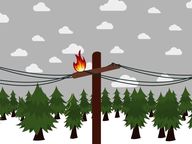Lots of spring power outages are caused by pole fires.
The top of a wooden distribution pole catches on fire when electricity accidentally moves from the power line to the pole. Pole fires can be very disruptive to our grid, often knocking out the power of an entire neighbourhoods.
They most often happen in springtime, or during warmer spells in winter.
Pole fires happen as humid air joins forces with dirt, salt, and grime, usually from traffic kicking up dirty mist that coats insulators, making a path for electricity to go from the line to the pole.
An insulator is made of non-conductive material and serves to separate the power line from things that could catch on fire. But when that non-conductive insulator gets covered in dirt, salt, and water, electricity can move from the power line along the coated insulator to the wooden distribution pole, causing a short circuit, which generates heat and starts fires.
The fire can then burn right through the pole and leave the pole’s cross-arms and insulators suspended by the wires. The outcome of a pole fire is almost always a power outage.
Watch this short video for a visual explanation:
Spring pole fires
Over the winter, salt and grime from traffic can build up on porcelain or polymer insulators that attach power lines to wood distribution poles. In the spring, humidity combines with this dirt and can create a pathway for electricity to travel from the line to the pole. This short circuit causes the wood to catch fire. Damaged poles like this are dangerous and almost always cause outages.
Pole fires can also occur through events like lightning from storms or damaged equipment, like a cracked insulator or cutout, but this is less common.
Poles damaged by fire usually need to be replaced – a job that can take many hours.
A damaged pole can be very dangerous. If you see one, stay away from the area and call 911 and Manitoba Hydro.





